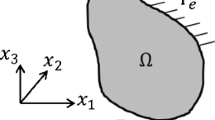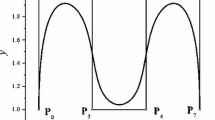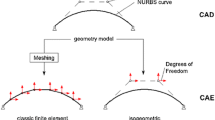Abstract
For almost a decade, the finite element absolute nodal coordinate formulation (ANCF) has been used for both geometry and finite element representations. Because of the ANCF isoparametric property in the cases of beams, plates and shells, ANCF finite elements lend themselves easily to the geometric description of curves and surfaces, as demonstrated in the literature. The ANCF finite elements, therefore, are ideal for what is called isogeometric analysis that aims at the integration of computer aided design and analysis (ICADA), which involves the integration of what is now split into the separate fields of computer aided design (CAD) and computer aided analysis (CAA). The purpose of this investigation is to establish the relationship between the B-spline and NURBS, which are widely used in the geometric modeling, and the ANCF finite elements. It is shown in this study that by using the ANCF finite elements, one can in a straightforward manner obtain the control point representation required for the Bezier, B-spline and NURBS geometry. To this end, a coordinate transformation is used to write the ANCF gradient vectors in terms of control points. Unifying the CAD and CAA will require the use of such coordinate transformations and their inverses in order to transform control points to position vector gradients which are required for the formulation of the element transformations in the case of discontinuities as well as the formulation of the strain measures and the stress forces based on general continuum mechanics theory. In particular, fully parameterized ANCF finite elements can be very powerful in describing curve, surface, and volume geometry, and they can be effectively used to describe discontinuities while maintaining the many ANCF desirable features that include a constant mass matrix, zero Coriolis and centrifugal forces, no restriction on the amount of rotation or deformation within the finite element, ability for straightforward implementation of general constitutive equations, and ability to capture coupled deformation modes that cannot be captured using existing finite element beam, plate and shell formulations. Because of the relationship between the ANCF finite elements and the B-splines, the development of a rational absolute nodal coordinate formulation (RANCF) is currently being explored. Furthermore, the relationship between the ANCF finite elements and B-splines and NURBS demonstrates that the use of B-splines and NURBS in the analysis will eventually lead to the same fundamental issues that have been already researched in the literature on the ANCF finite elements.
Similar content being viewed by others
References
Piegl, L., Tiller, W.: The NURBS Book, 2nd edn. Springer, New York (1997)
Dierckx, P.: Curve and Surface Fitting with Splines. Oxford University Press, London (1993)
Farin, G.: Curves and Surfaces for CAGD, A Practical Guide, 5th edn. Morgan Kaufmann, San Mateo (1999)
Bathe, K.J.: Finite Element Procedures. Prentice Hall, Englewood Cliffs (1996)
Cook, R.D., Malkus, D.S., Plesha, M.E.: Concepts and Applications of Finite Element Analysis, 3rd edn. Wiley, New York (1989)
Crisfield, M.A.: Nonlinear Finite Element Analysis of Solids and Structures, Vol. 1: Essentials. Wiley, New York (1991)
Zienkiewicz, O.C., Taylor, R.L.: The Finite Element Method, Vol. 2: Solid Mechanics, 5th edn. Butterworth Heinemann, Oxford (2000)
Bazilevs, Y., Calo, V.M., Cottrell, J.A., Evans, J., Hughes, T.J.R., Lipton, S., Scott, M.A., Sederberg, T.W.: Isogeometric analysis: towards unification of computer aided design and finite element analysis. In: Papadrakakis, M., Topping, B.H.V. (eds.) Trends in Engineering Computational Technology. Saxe-Coburg Publications, Stirlingshire (2008)
Cottrell, J.A., Hughes, T.J.R., Reali, A.: Studies of refinement and continuity in the isogeometric analysis. Comput. Methods Appl. Mech. Eng. 196, 4160–4183 (2007)
Shabana, A.A.: An Absolute Nodal Coordinate Formulation for the Large Rotation and Deformation Analysis of Flexible Bodies. Technical Report #MBS96-1-UIC, Department of Mechanical Engineering, University of Illinois at Chicago, March 1996
Shabana, A.A.: Dynamics of Multibody Systems, 3rd edn. Cambridge University Press, Cambridge (2005)
Shabana, A.A.: Computational Continuum Mechanics. Cambridge University Press, Cambridge (2008)
Berzeri, M., Sany, J.R., Shabana, A.A.: Curved Track Modeling Using the Absolute Nodal Coordinate Formulation. Technical Report #MBS00-4-UIC, Department of Mechanical Engineering, University of Illinois at Chicago, Chicago (2000)
Shabana, A., Zaazaa, K.E., Sugiyama, H.: Railroad Vehicle Dynamics: A Computational Approach. Taylor and Francis/CRC, Boca Raton (2008)
Dmitrochenko, O.N., Pogorelov, D.Y.: Generalization of plate finite elements for absolute nodal coordinate formulation. Multibody Syst. Dyn. 10(1), 17–43 (2003)
Garcia-Vallejo, D., Mayo, J., Escalona, J.L., Dominguez, J.: Efficient evaluation of the elastic forces and the Jacobian in the absolute nodal coordinate formulation. Nonlinear Dyn. 35(4), 313–329 (2004)
Gerstmayr, J., Shabana, A.A.: Analysis of thin beams and cables using the absolute nodal coordinate formulation. Nonlinear Dyn. 45, 109–130 (2006)
Mikkola, A.M., Matikainen, M.K.: Development of elastic forces for the large deformation plate element based on the absolute nodal coordinate formulation. ASME J. Comput. Nonlinear Dyn. 1(2), 103–108 (2006)
Mikkola, A.M., Shabana, A.A.: A non-incremental finite element procedure for the analysis of large deformation of plates and shells in mechanical system applications. Multibody Syst. Dyn. 9(3), 283–309 (2003)
Schwab, A.L., Meijaard, J.P.: Comparison of three-dimensional beam elements for dynamic analysis: finite element method and absolute nodal coordinate formulation. In: Proceedings of the ASME 2005 International Design Engineering Technical Conferences & Computer and Information in Engineering Conference (DETC2005-85104), Long Beach, California, September 24–28 (2005)
Sopanen, J.T., Mikkola, A.M.: Description of elastic forces in absolute nodal coordinate formulation. Nonlinear Dyn. 34(1–2), 53–74 (2003)
Yoo, W.S., Lee, J.H., Park, S.J., Sohn, J.H., Pogorelov, D., Dimitrochenko, O.: Large deflection analysis of a thin plate: computer simulation and experiment. Multibody Syst. Dyn. 11(2), 185–208 (2004)
Maqueda, L.G., Shabana, A.A.: Poisson modes and general nonlinear constitutive models in the large displacement analysis of beams. J. Multibody Syst. Dyn. 18(3), 375–396 (2007)
Shabana, A.A., Mikkola, A.M.: Use of the finite element absolute nodal coordinate formulation in modeling slope discontinuity. ASME J. Mech. Des. 125(2), 342–350 (2003)
Author information
Authors and Affiliations
Corresponding author
Rights and permissions
About this article
Cite this article
Sanborn, G.G., Shabana, A.A. On the integration of computer aided design and analysis using the finite element absolute nodal coordinate formulation. Multibody Syst Dyn 22, 181–197 (2009). https://doi.org/10.1007/s11044-009-9157-3
Received:
Accepted:
Published:
Issue Date:
DOI: https://doi.org/10.1007/s11044-009-9157-3




